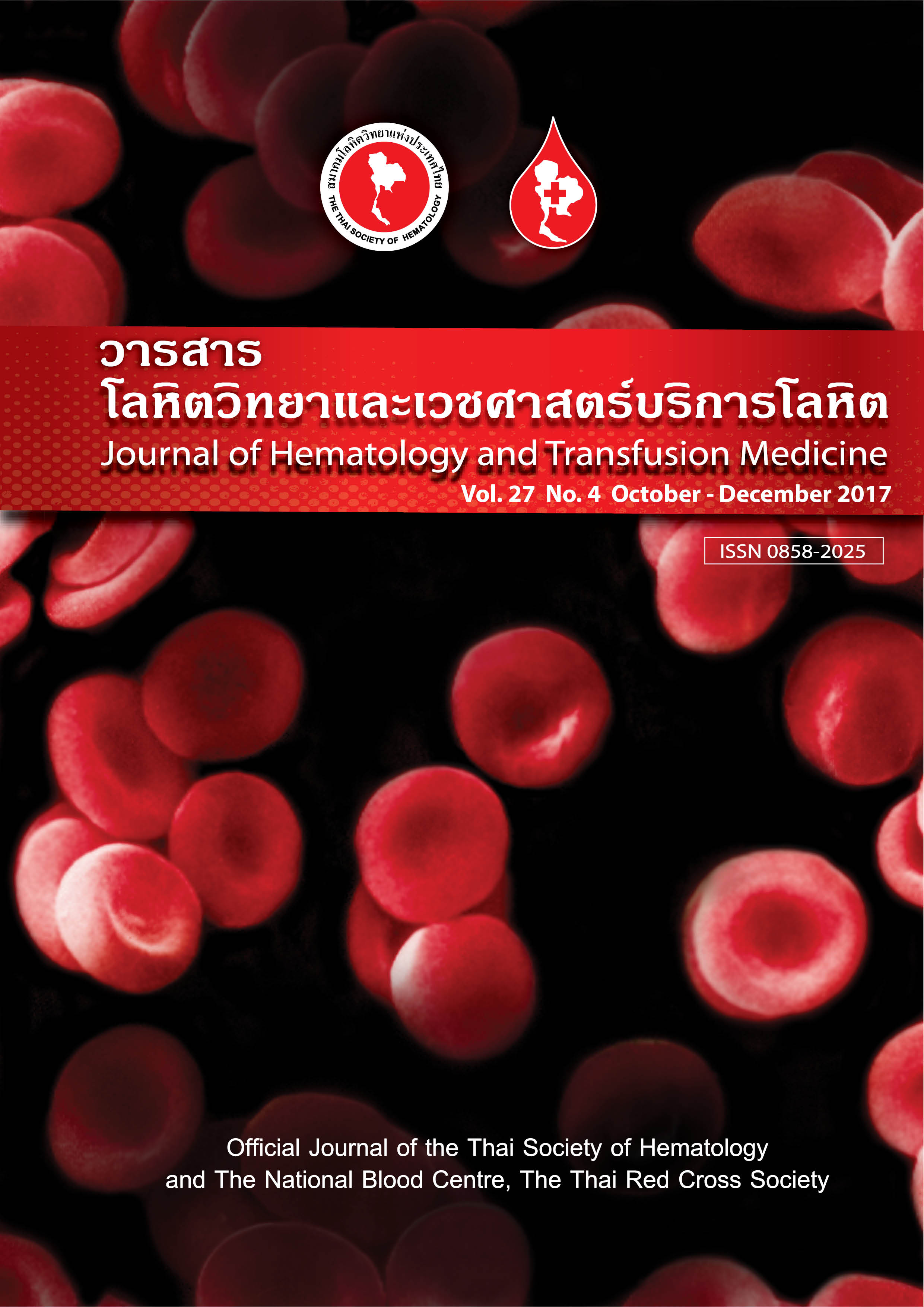Subgroups of A in Thai Blood Donors
คำสำคัญ:
Subgroups of A, Anti-A1, Non-A1, Imbalance of A2B and A2บทคัดย่อ
Abstracts:
The frequency of subgroups of A was found to be varied among different populations. The occurrence of anti-A1 in some cases may lead to the problem in blood transfusion, if they were clinically significant. Objective:This study aimed to reveal the frequency of A subgroups in Thai blood donors. The occurrence and reactivity pattern of anti-A1 in A2, A2B and other A subgroup individuals were also studied. Materials and Methods: A total of 13,028 group A and 4,563 group AB were identified during July10, 2017 to August 5, 2017. The techniques used in this study included standardtube technique for agglutination and indirect antiglobulin test. Results:Among group A, the frequencies of A1, A2 and A3 were 13,000 (99.78%), 23(0.18%) and 5(0.04%),respectively. For group AB, the frequencies of A1B, A2B and A3B were 4,483 (98.25%), 59 (1.29%) and 21 (0.46%), respectively. Approximately, 21.30%, 4.63%,54.63% and 19.44% of total 108 A and AB subgroups were A2, A3, A2B and A3B, respectively. Anti-A1 detected at 4๐C was higher in number than at room temperature for A2 andA2B. The most common reactivity pattern that showed discrepancy in ABO typing was for A2B with weak anti-A1. All of anti-A1 found were of no clinical significance. Conclusion: The low frequency of A subgroup distribution in group A and group AB and the imbalance in A2 and A2B phenotype frequencies of ABO group in Thai blood donors were observed. In addition, anti-A1 in all subgroups of A in this study showed no clinical significance.
บทคัดย่อ
ความถี่ของหมู่เลือดย่อย A ของหมู่ A และ AB มีความหลากหลายในประชากรต่างๆ และที่สำคัญคือ การพบว่า ซีรัมของคนที่มีหมู่เลือดย่อยบางรายมี anti-A1ซึ่งหากเป็นชนิดที่มีความสำคัญทางคลินิก อาจทำให้เกิดปัญหาในการรับโลหิตได้ วัตถุประสงค์ เพื่อศึกษาความถี่ของหมู่ย่อยของ A ในผู้บริจาคโลหิตคนไทย รวมทั้งศึกษาปฏิกิริยาของ anti-A1 ในคนหมู่ย่อย A2, A2B และหมู่ย่อยชนิดอื่นๆ วัสดุและวิธีการ ทำการศึกษาระหว่างวันที่ 10 กรกฎาคม - 5 สิงหาคม พ.ศ. 2560 ได้ตรวจตัวอย่างโลหิตหมู่ A จำนวน13,028 ตัวอย่าง และหมู่ AB จำนวน 4,563 ตัวอย่าง โดยทดสอบปฏิกิริยาการจับกลุ่ม และ indirect antiglobulin test ด้วยวิธีหลอดทดลอง ผลการศึกษา ในกลุ่มหมู่ A ความถี่ของ A1, A2 และ A3 เท่ากับ 13,000 (99.78%), 23 (0.18%) และ 5 (0.04%) ตามลำดับ ส่วน หมู่ AB, มีความถี่ของ A1B, A2B และA3B เท่ากับ 4,483 (98.25%), 59 (1.29%) และ 21 (0.46%) ตามลำดับ anti-A1 ที่ตรวจได้ที่อุณหภูมิ 4๐C มีจำนวนเพิ่มขึ้นจากที่ตรวจได้ที่อุณหภูมิห้อง สำหรับ A2 และA2B ส่วนปฏิกิริยาที่พบบ่อยที่ทำให้มีความไม่สอดคล้องระหว่าง เซลล์และซีรัม ของหมู่โลหิต ABO คือ กลุ่ม A2B ที่มี anti-A1 สำหรับ anti-A1 ที่พบทั้งหมดในการศึกษานี้ ทำปฏิกิริยาอย่างอ่อนและเป็นชนิดที่ทำปฏิกิริยาได้ดีในอุณหภูมิต่ำ ซึ่งนับได้ว่าไม่มีความสำคัญทางคลินิก สรุป ความถี่ของหมู่ย่อยของ A ในหมู่ A และ AB พบได้น้อยมาก และพบความไม่สมดุลของ A2 และ A2B ของหมู่เลือด ABO นอกจากนี้ยังพบว่า anti-A1 ที่ตรวจได้ในหมู่ย่อยทั้งหมดของ A ในการศึกษานี้ ไม่มีความสำคัญทางคลินิก



